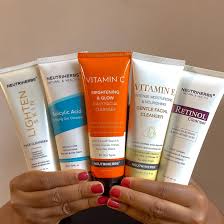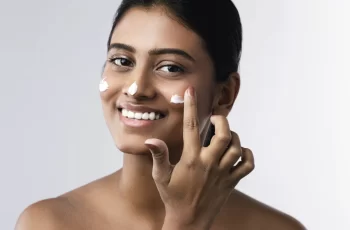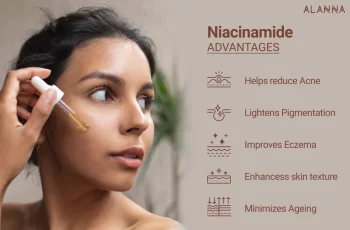What type of facial cleanser is best for you?
Many of us believe that our day only begins after we wash our face. The first step in your skincare routine plays an important role and sets the tone for the rest of the products that follow.
Opinions vary on when to use a facial cleanser and what ingredients to use. However, one thing every beauty expert will recommend is to make sure you use the right cleanser for your skin type.
Don’t worry, it’s not as confusing as it sounds. We’ll give you some tips and advice to help you find the right product for you – a skincare matchmaker, so to speak!
What does facial cleansing do? The job of facial cleansing is to remove anything from your skin that could cause harm. Pollution, harmful bacteria, excess oil, makeup stains, and dead skin cells are all free radicals,
which, if left on your face, can cause acne, redness, and even signs of premature aging.
Face cleansers should not be confused with makeup removers and are not typically used to remove makeup like foundation and mascara. In order for your face cleanser to work its true magic, you should remove your makeup first.
Otherwise, you’re rubbing the product into your skin, which can lead to skin issues like rashes and uneven texture.
There’s no way to stop these harmful particles from accumulating on your skin. That’s why it’s so important to wash them off at the end of each day. You can also wash your face in the morning, although some experts disagree on the ideal frequency of skin cleansing.
Half of the respondents believe that there’s no real benefit to washing your face in the morning and that the focus should be on the evening, as the skin is exposed to a range of environmental factors and stressors throughout the day. In other words, washing twice a day is best for your skin.
If you want to learn more, read our blog post “How Often Should You Wash Your Face and Why?” Does It Make Any Difference If I Don’t Use a Face Cleanser?
In any case, yes. Given the wide range of face cleansers that have appeared on the market in the past few years, there’s no reason not to wash your face or to just use water.
The skin has a 30-day cell cycle, which means it can go through cell turnover and shed layers of dead skin cells.
This cycle can be temporarily disrupted, causing dead skin cells to build up, leading to breakouts and a dull complexion, and creating a barrier for skincare products like serums and moisturizers to penetrate the lower layers of the skin.
By washing your face, you remove deep-rooted dirt, debris, and bacteria while removing dead skin cells and other skin-damaging free radicals. Which face cleanser works best? As with all products, it’s best to use a formula that’s right for your skin type.
Here are some examples of face cleanser ingredients that work best for your skin type and texture
Fair skin types. The best face cleansers for dull skin types contain chemical exfoliants, such as popular AHAs like glycolic acid and vitamin C.
Both of these ingredients add radiance to your skin and remove any barriers that prevent other topical treatments from penetrating deeper into the skin.
Choose products with AHAs like glycolic acid and vitamin C for a revitalized, radiant complexion.
All types of face cleansers, such as milks, lotions, balms, and gels are suitable for dull skin. Don’t forget to apply a conditioning serum after washing to maintain your glow.
A face cleanser can be used both morning and night, but you should always apply a moisturizer afterward. Dry Skin Type. While washing your face is a great start to your skin care routine, it can leave your skin very dry if you’re not careful.
If you have dry skin, you need a cleanser that not only removes all the flaky areas and dead skin cells, but also cleanses the skin gently. AHA lactic acid is great for dry skin because it gently exfoliates while retaining moisture.
You should also look for non-foaming formulas because they can also dry out the skin. It’s best to use a face cleanser at night after removing your makeup. This will cleanse your skin without leaving it feeling too harsh.
Choose a formula with lactic acid because it gently exfoliates and locks in moisture. Cleansers, lotions, and cream formulas are best for dry skin. To prevent dry skin, use a face cleanser at night.
Oily Skin Type. While some say that face cleansers don’t stay on your face long enough to have a big impact on your skin, it’s still a good idea to be aware of your skin type and how to keep it looking and feeling healthy.
If you have oily or acne-prone skin, choose an oil-free face cleanser to avoid excess oil, which can throw your skin off balance. Ideally, use a face cleanser twice a day, but not too often, and only if it’s not too harsh or irritating to your skin.
Allow the cleanser ingredients to penetrate all of your feet. Salicylic acid penetrates the deepest layers of the skin, opening clogged pores and removing dead skin cells.
You can use a toner twice a day, but not more than once, as this strips the oils from your skin, leading to more oil production and breakouts. Ingredients like salicylic acid cleanse the skin thoroughly. Choose an oil-free gel formula to keep your skin happy. If you want to create an effective skincare routine, it’s important to pay attention to the ingredients and texture of your face cleanser, and consider your skin type to ensure you find a product that’s right for you. How much you want to spend on a face cleanser depends on your personal budget. Although many in the beauty industry say that as long as the product works and delivers results, it’s worth it regardless of the price, whether it costs £6 or £67. What happens if I use a face cleanser that’s not suitable for my skin type? Don’t worry, it’s not as dramatic as it sounds. Dry skin feels tight and uncomfortable, dull skin doesn’t see any improvement in its complexion, and oily skin struggles with excess oil and shine.These are just some small signs that you are not using the right product and can be easily remedied. If you notice redness, rash, itching or blistering on your skin, you must stop using the product immediately and seek advice from your GP or dermatologist. Here you can find more information on how to find the right face wash for your skin. If you still want to know more about the ingredients, check out our blog post with everything you need to know about AHAs and BHAs.
DQH Knowledge drop: In your 20s, your skin cell turnover decreases. (Cell turnover is a key component in keeping your skin youthful.) You know what else slows down? Your collagen production. Starting in your 20s, collagen decreases by about 1 percent per year. Should you want to prevent fine lines and wrinkles, start by eliminating behaviors that contribute to premature aging. “If it’s bad for you, it’s bad for your skin,” says dermatologist Michel Somenek.
“Cigarette smoking reduces blood flow to the skin and causes premature wrinkling and a dull skin texture. Making the repeated pursed motion to inhale can also cause smoker’s lines. Alcohol and recreational drugs are toxins for the skin that damage its cellular structure and DNA,” Somenek tells us. “The faster you eliminate vices while you are young, the better chance your skin and body have to recuperate.” Also, adopting an anti-aging routine in your 20s is key. After all, the best offense is a good defense. We spoke to Somenek and experts Joshua Ross and Audrey Kunin to find out more.
Keep reading for the best anti-aging products for your 20s, according to skincare professionals.
Sunscreen
“We all know that the sun is the number one cause of skin aging and starting the prevention in your 20s is very important,” Ross says. “The majority of your sun damage won’t start to appear until you’re in your 30s, so don’t wait until you see it surface or you’ll be behind the curve. Stay ahead of it with a good-quality zinc-based sunscreen worn daily.”
Farmacy Green Defense Daily Mineral Sunscreen
An invisible sunscreen with SPF 30, plus botanical extracts meant to protect skin with tons of antioxidants. Bonus: It’s clean and fine to use under makeup.
Bareminerals Complexion Rescue™ Tinted Moisturizer Broad Spectrum SPF 30
Although we recommend you use your SPF and moisturizer separately, we also understand moments when you don’t have time or energy for that extra step. For those times, this bareMinerals moisturizer is a great thing to have on hand.
Vitamin C Serum
“A great introduction to anti-aging is to start with a vitamin C serum in your morning skincare routine,” Ross says. “It’s a powerful antioxidant that will neutralize free radicals and brighten the skin.” He adds that it’s a great way to counteract the effects of the sun’s harmful rays, which, as previously mentioned, are among the biggest causes of premature aging.
Drunk Elephant C-Firma™ Vitamin C Day Serum
The Drunk Elephant C-Firma is a lightweight serum that promises to give skin a glow by combining the brightening powers of vitamin C with ferulic acid, l-ascorbic acid, and vitamin E. The included sodium hyaluronate is meant to replace hydration loss, so you shouldn’t have to deal with any irritation.
Sunday Riley C.E.O. Rapid Flash Brightening Serum
This potent serum is jam-packed with vitamin C (15 percent, to be exact), which means it’s a potential superstar at both brightening skin and dousing it in antioxidants.
Peptides
Using peptides on your skin has many benefits, says Somenek. “The skin barrier is what defends the body against pollution, UV rays, bacteria, and toxins. It can be damaged by several everyday factors. Using topical peptides aids in building a stronger barrier,” he says. “Peptides comprise elastic fibers, which are a type of protein. These fibers help to make skin appear taut and firm. Peptides can also help repair damaged skin, relieve inflammation, and even out skin tone. Some peptides can kill acne-causing bacteria that is common in 20-somethings.”
Kunin agrees, saying, “Peptides are an excellent entry point for supporting collagen.” She recommends looking for face and eye treatments that contain these collagen-boosting powerhouses.
Charlotte Tilbury Magic Eye Rescue Cream
This Charlotte Tilbury super-emollient eye cream has a base of coconut oil and shea butter (read: it’s incredibly hydrating). Botanicals plus peptides are meant to help reduce dark circles and boost collagen, respectively.
This creamy moisturizer serves up potent collagen-boosting peptides and pycnogenol, and antioxidant-rich vitamin C. “Instead of sitting on top of the skin, peptides penetrate the outer layer so they go deep. The ‘signals’ they send tell the cells to produce elastin and collagen, which are needed for youthful-looking skin,” explains Somenek.
At-Home Peel Pads
Remember that skin cell turnover fiasco we talked about earlier? One way to help support it is by exfoliating. “Exfoliation is important to help keep skin fresh and luminous,” Kunin says. She recommends using at-home peel pads as an easy and effective way to exfoliate.
“The goal in your 20s is to fight the slowing pace of cell turnover. It is wise to use products that gently exfoliate, yet still remove oil and other impurities. Products that have Alpha Hydroxy Acids (AHA) or Beta Hydroxy Acids (BHA) are a good choice.”
According to Somenek, you should only exfoliate two to three times a week. “People of all ages are guilty of over-exfoliating and that can be too much of a good thing,” he says.
Dermadoctor Kakadu C Intensive Vitamin C Peel Pad
A few swipes of this Derma Doctor powerful peel pad promise to leave your skin glowing and smooth, thanks to the seven (yes, seven) types of chemical exfoliants, including AHA and BHA. It also contains vitamin C via Kakadu plum extract for added brightening and antioxidant protection.
KEY INGREDIENTS Kakadu plum extract is sourced from the Kakadu plum, a fruit grown in northern Australia. It contains vitamin C, which restores the skin’s natural barrier, increases collagen production, and soothes irritation.
Dr. Dennis Gross Skincare Alpha Beta® Universal Daily Peel Pads
These are the gold standard of peel pads, with a cult following and over 900 five-star reviews on Sephora. They’re easy to use and contain a blend of anti-aging exfoliating acids.
Emollient Night Cream
“In your 20s, you need to start upping the hydration in your skincare routine. You may have been cautious of over-moisturizing because of acne in your teens, but as you enter your 20s, your skin transitions and becomes drier,” Ross says. “I recommend an emollient night cream added into your evening skincare regimen.”
“Twenty-somethings need to make sure that they are not using creams that will clog their pores and cause excess oil production,” says Somenek. Opt for non-comedogenic products.
Cerave Skin Renewing Night Cream
One great choice is the CeraVe Skin Renewing Night Cream, which is a non-comedogenic night cream that leaves skin soft and glowy. It combines the moisturizing powers of ceramides and hyaluronic acid.
RoC Retinol Correxion Max Hydration Creme
“The best night cream ingredients contain retinol, benzoyl peroxide, and/or salicylic acid or hyaluronic acid. The goal is to moisturize, yet remove excess oil,” says Somenek. This Roc Retinol Correxion cream fits the bill as it contains both hyaluronic acid and retinol so it promises to moisturize while also being non-comedogenic.



